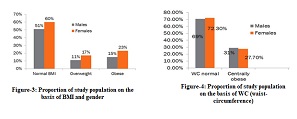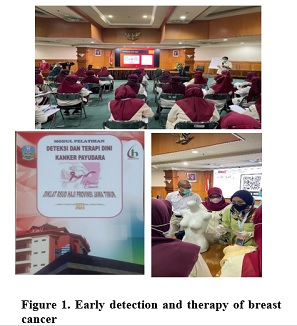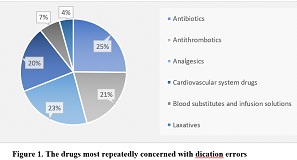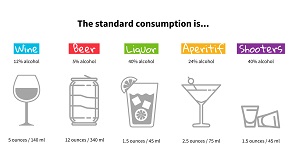Latrines Problem, Defecation Behavior, and Implementation of GERBANG JASA in Murtajih Village, Pamekasan, Indonesia
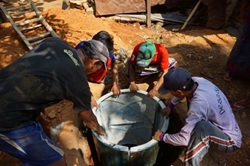
Downloads
Unhealthy latrines and defecation behaviors are associated with a higher diarrhea and stunting incidence. The authors developed Healthy Latrine Building Program (GERAKAN BANGUN JAMBAN SEHAT), which is was abbreviated as Gerbang Jasa, to improve latrine problems and long-term effort to prevent stunting. This study aimed to describe the latrine problems and implementation of Gerbang Jasa in Murtajih Village, Pamekasan., Indonesia This research was a descriptive study and involved all families with unhealthy or sharing latrines in Telaga Sari and Pao Gading, Murtajih. We assessed the knowledge and family characteristics through a questionnaire and collected children's height and age under five years. Thirty families were included in this study, 16 from Pao Gading and 14 from the Telaga Sari. Half of them used unhealthy latrine (cemplung) and the others shared latrines, 59% of farmer occupation and most of them had income under Rp.1.000.000,00. Meanwhile, 12 children under five years from their family was not stunted. During our movement, the authors got funds Rp 18.261.000,00 and successfully built 63,3% latrines with sept tank, 16,7% of latrines only and all the unhealthy latrines were closed by subject. Farmer occupation, family income under Rp 1.000.000,00 were the most cause of latrines problems. Meanwhile, Gerbang jasa could improve latrines problem in Murtajih Village, Pamekasan.
Badan Pusat Statistik. (2020). Persentase Rumah Tangga menurut Provinsi dan Memiliki Akses terhadap Sanitasi Layak (Persen), 2018-2020.
Badriyah, L., & Syafiq, A. (2017). The Association Between Sanitation, Hygiene, and Stunting in Children Under Two-Years (An Analysis of Indonesia's Basic Health Research, 2013). Makara Journal of Health Research, 21(2). https://doi.org/10.7454/msk.v21i2.6002
Committee on Health and Behavior. (2001). Health and Behavior: The Interplay of Biological, Behavioral, and Societal Influences. National Academy Press.
Darsana, I. N., Mahayana, I. M. B., & Patra, I. M. (2014). Faktor-faktor yang Berhubungan Dengan Kepemilikan Jamban Keluarga di Desa Jehem Kecamatan Tembuku Kabupaten Bangli Tahun 2012. Jurnal Kesehatan Lingkungan, 4(2), 124–133.
Garn, J. V., Sclar, G. D., Freeman, M. C., Penakalapati, G., Alexander, K. T., Brooks, P., Rehfuess, E. A., Boisson, S., Medlicott, K. O., & Clasen, T. F. (2017). The impact of sanitation interventions on latrine coverage and latrine use: A systematic review and meta-analysis. International Journal of Hygiene and Environmental Health, 220(2), 329–340. https://doi.org/10.1016/j.ijheh.2016.10.001
Gebremedhin, G., Tetemke, D., Gebremedhin, M., Kahsay, G., Zelalem, H., Syum, H., & Gerensea, H. (2018). Factors associated with latrine utilization among model and non-model families in Laelai Maichew Woreda, Aksum, Tigray, Ethiopia: comparative community based study. BMC Research Notes, 11(1), 586. https://doi.org/10.1186/s13104-018-3683-0
Kementerian Kesehatan Republik Indonesia. (2019). Laporan Provinsi Jawa Timmur Riskesdas 2018. Lembaga Penerbit Badang Litbang Kesehatan.
Kwami, C. S., Godfrey, S., Gavilan, H., Lakhanpaul, M., & Parikh, P. (2019). Water, Sanitation, and Hygiene: Linkages with Stunting in Rural Ethiopia. International Journal of Environmental Research and Public Health, 16(20), 3793. https://doi.org/10.3390/ijerph16203793
Laika, A., & Adriyani, R. (2021). the Relationship of Respondent Characteristics, Knowledge, Attitudes, and Ownership of Latrines Towards Its Low Use of Latrines in Gunung Anyar Village, Surabaya City. The Indonesian Journal of Public Health, 16(2), 188. https://doi.org/10.20473/ijph.v16i2.2021.188-195
Peraturan Menteri Kesehatan Republik Indonesia Nomor 3 Tahun 2014 Tentang Sanitasi Total Berbasis Masyarakat, (2014).
Moyo, W., & Moyo, M. (2017). Factors contributing to Low Sanitation and Hygiene Coverage: A Case of Blair Ventilated Improved Pit Latrines in Matetsi Ward, Hwange District. International Journal of Academic Rersearch in Business and Social Sciences, 7(3), 180–191. https://doi.org/10.6007/IJARBSS/v7-i3/2709
Notoadmodjo, S. (2014). Promosi Kesehatan dan Perilaku Kesehatan. Rineka Cipta.
Nshimyiryo, A., Hedt-Gauthier, B., Mutaganzwa, C., Kirk, C. M., Beck, K., Ndayisaba, A., Mubiligi, J., Kateera, F., & El-Khatib, Z. (2019). Risk factors for stunting among children under five years: a cross-sectional population-based study in Rwanda using the 2015 Demographic and Health Survey. BMC Public Health, 19(1), 175. https://doi.org/10.1186/s12889-019-6504-z
Pademawu Community Health Center. (2018). Laporan Data Sharing Jamban Puskesmas Pademawu Tahun 2018.
Psaki, S. R., Seidman, J. C., Miller, M., Gottlieb, M., Bhutta, Z. A., Ahmed, T., Ahmed, A. S., Bessong, P., John, S. M., Kang, G., Kosek, M., Lima, A., Shrestha, P., Svensen, E., & Checkley, W. (2014). Measuring socioeconomic status in multicountry studies: results from the eight-country MAL-ED study. Population Health Metrics, 12(1), 8. https://doi.org/10.1186/1478-7954-12-8
World Bank. (2013). East Asia Pacific Region Urban Sanitation Review: Indonesia Country Study. World Bank, September, 1–68.
World Health Organization. (2019). Sanitation. https://www.who.int/news-room/fact-sheets/detail/sanitation
Copyright (c) 2022 Steven Christian Susianto, Israna Israna, Izaratul Haque, Melyana Habibie, Sri Mentari Br Ginting, Jeni Novita Anggraini

This work is licensed under a Creative Commons Attribution-ShareAlike 4.0 International License.
- The journal allows the author to hold the copyright of the article without restrictions.
- The journal allows the author(s) to retain publishing rights without restrictions.
- The legal formal aspect of journal publication accessibility refers to Creative Commons Attribution Share-Alike (CC BY-SA).
- The Creative Commons Attribution Share-Alike (CC BY-SA) license allows re-distribution and re-use of a licensed work on the conditions that the creator is appropriately credited and that any derivative work is made available under "the same, similar or a compatible license”. Other than the conditions mentioned above, the editorial board is not responsible for copyright violation.

























